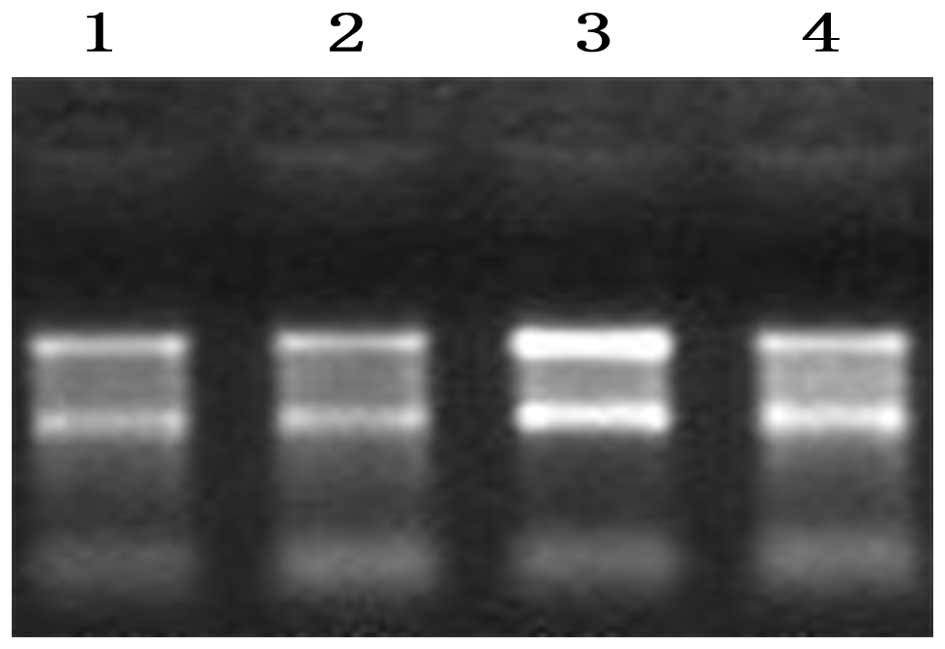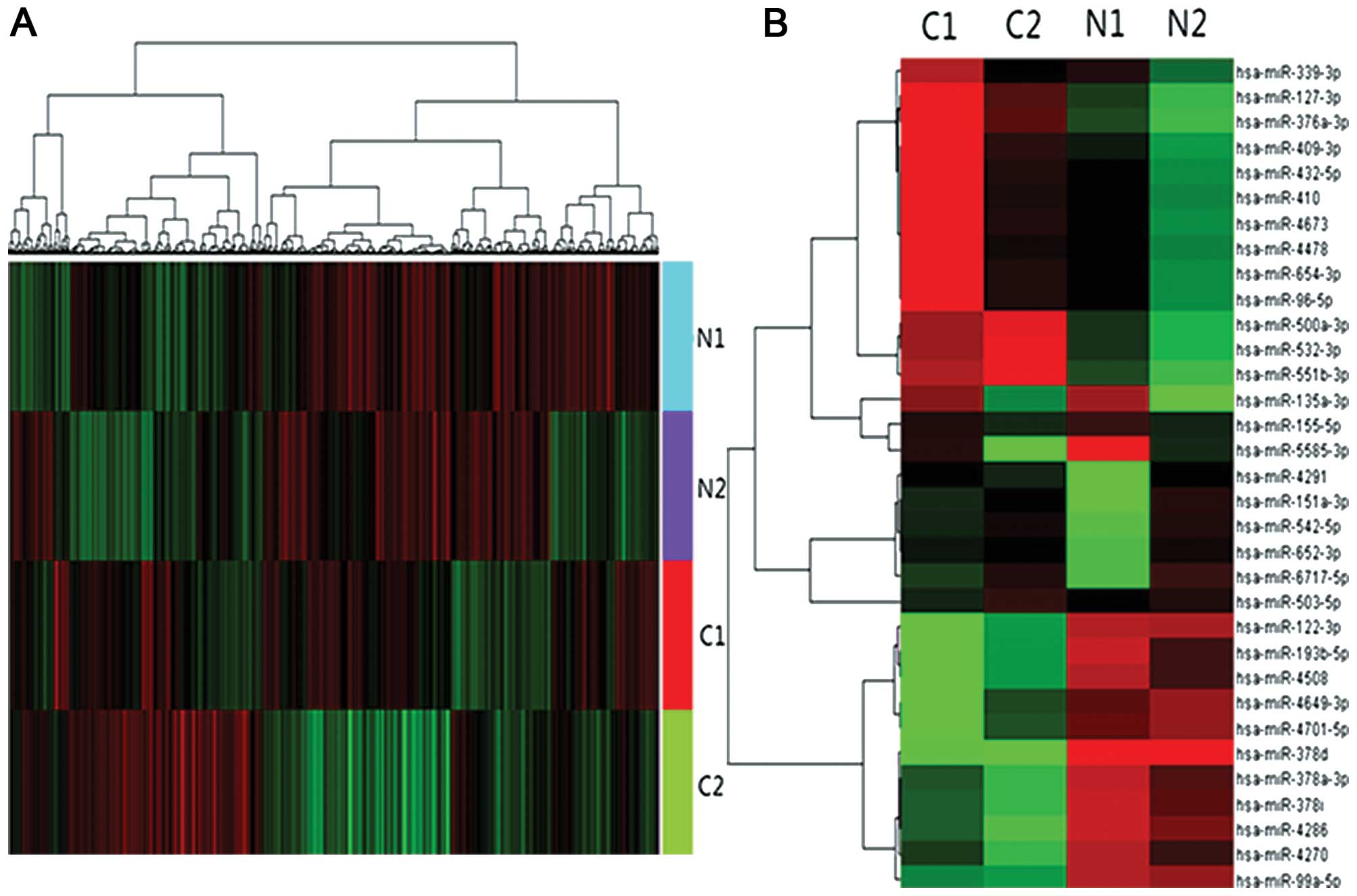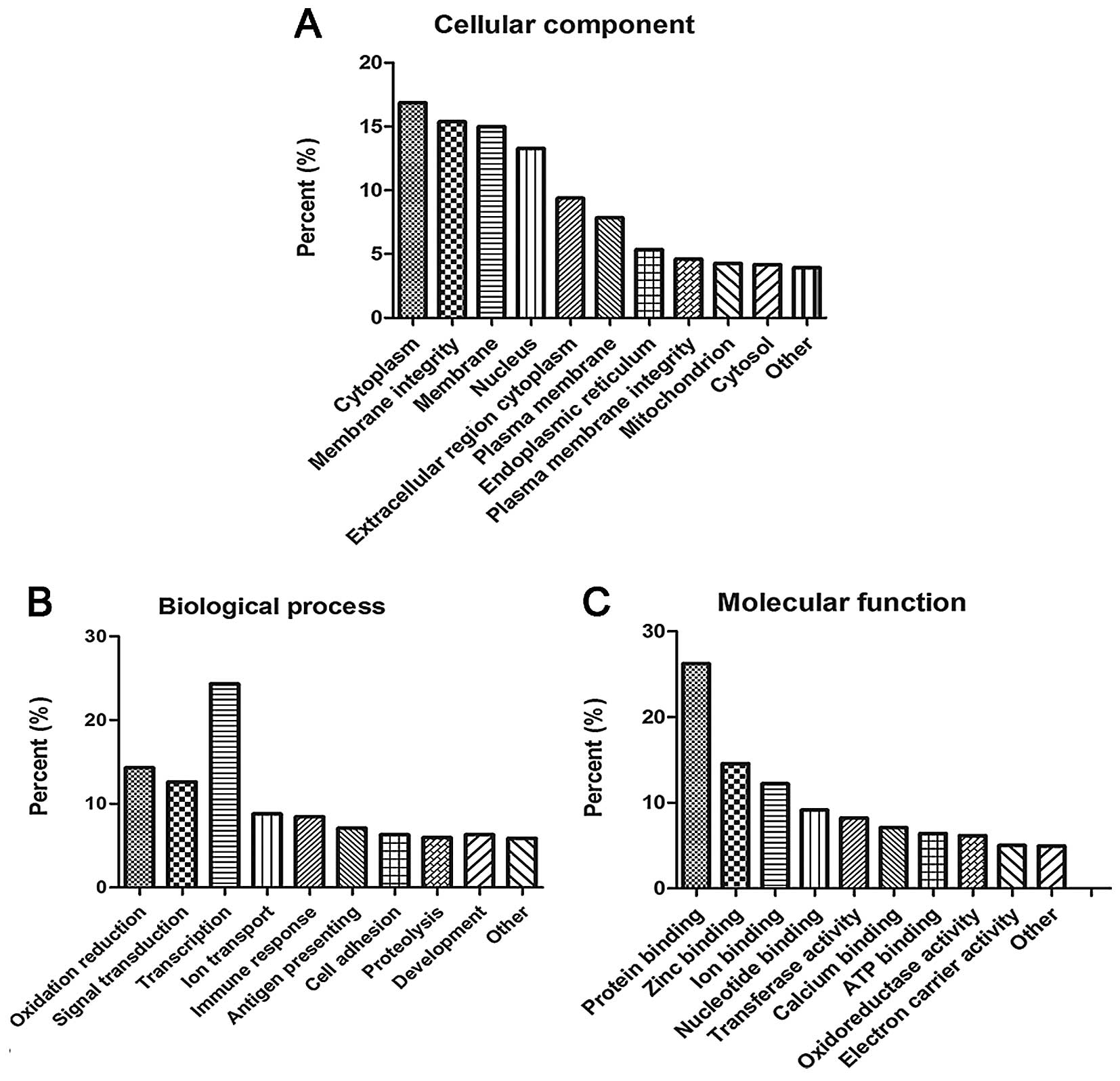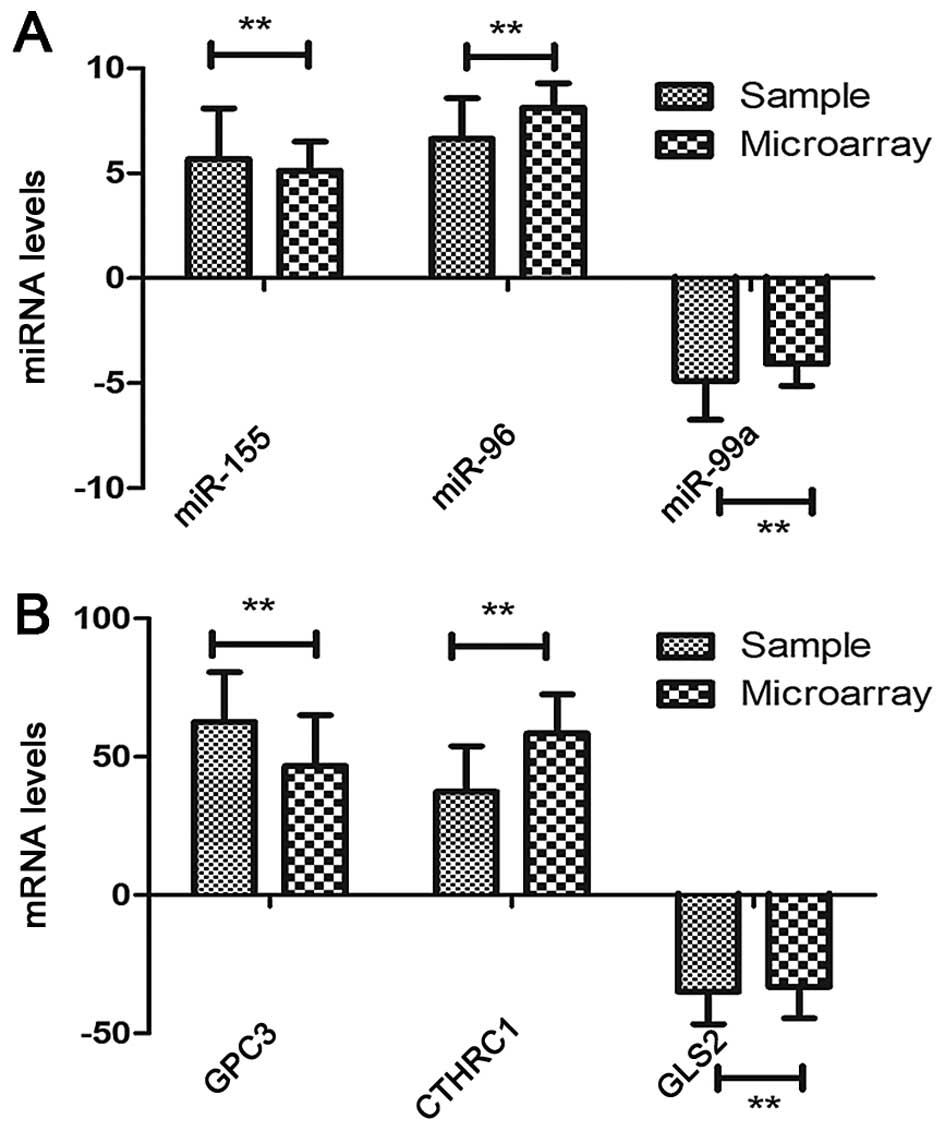|
1
|
Bosetti C, Turati F and La Vecchia C:
Hepatocellular carcinoma epidemiology. Best Pract Res Clin
Gastroenterol. 28:753–770. 2014. View Article : Google Scholar : PubMed/NCBI
|
|
2
|
Mikhail S, Cosgrove D and Zeidan A:
Hepatocellular carcinoma: Systemic therapies and future
perspectives. Expert Rev Anticancer Ther. 14:1205–1218. 2014.
View Article : Google Scholar : PubMed/NCBI
|
|
3
|
Morishita A and Masaki T: miRNA in
hepatocellular carcinoma. Hepatol Res. 45:128–141. 2014. View Article : Google Scholar : PubMed/NCBI
|
|
4
|
Mathew S, Ali A, Abdel-Hafiz H, Fatima K,
Suhail M, Archunan G, Begum N, Jahangir S, Ilyas M, Chaudhary AG,
et al: Biomarkers for virus-induced hepatocellular carcinoma (HCC).
Infect Genet Evol. 26:327–339. 2014. View Article : Google Scholar : PubMed/NCBI
|
|
5
|
Wu CS, Lee TY, Chou RH, Yen CJ, Huang WC,
Wu CY and Yu YL: Development of a highly sensitive glycan
microarray for quantifying AFP-L3 for early prediction of hepatitis
B virus-related hepatocellular carcinoma. PLoS One. 9:e999592014.
View Article : Google Scholar : PubMed/NCBI
|
|
6
|
Murakami Y, Tanahashi T, Okada R, Toyoda
H, Kumada T, Enomoto M, Tamori A, Kawada N, Taguchi YH and Azuma T:
Comparison of hepatocellular carcinoma miRNA expression profiling
as evaluated by next generation sequencing and microarray. PLoS
One. 9:e1063142014. View Article : Google Scholar : PubMed/NCBI
|
|
7
|
He TL, Zheng KL, Li G, Song B and Zhang
YJ: Identification of typical miRNAs and target genes in
hepatocellular carcinoma by DNA microarray technique. Eur Rev Med
Pharmacol Sci. 18:108–116. 2014.PubMed/NCBI
|
|
8
|
Wang L, Yao J, Zhang X, Guo B, Le X,
Cubberly M, Li Z, Nan K, Song T and Huang C: miRNA-302b suppresses
human hepatocellular carcinoma by targeting AKT2. Mol Cancer Res.
12:190–202. 2014. View Article : Google Scholar
|
|
9
|
Yan H, Wang S, Yu H, Zhu J and Chen C:
Molecular pathways and functional analysis of miRNA expression
associated with paclitaxel-induced apoptosis in hepatocellular
carcinoma cells. Pharmacology. 92:167–174. 2013. View Article : Google Scholar : PubMed/NCBI
|
|
10
|
Kogure T, Kondo Y, Kakazu E, Ninomiya M,
Kimura O and Shimosegawa T: Involvement of miRNA-29a in epigenetic
regulation of transforming growth factor-β-induced
epithelial-mesenchymal transition in hepatocellular carcinoma.
Hepatol Res. 44:907–919. 2014. View Article : Google Scholar
|
|
11
|
Zhang J, Wang Y, Zhen P, Luo X, Zhang C,
Zhou L, Lu Y, Yang Y, Zhang W and Wan J: Genome-wide analysis of
miRNA signature differentially expressed in doxorubicin-resistant
and parental human hepatocellular carcinoma cell lines. PLoS One.
8:e541112013. View Article : Google Scholar : PubMed/NCBI
|
|
12
|
Zhuo L, Liu J, Wang B, Gao M and Huang A:
Differential miRNA expression profiles in hepatocellular carcinoma
cells and drug-resistant sublines. Oncol Rep. 29:555–562. 2013.
|
|
13
|
Fang L, Du WW, Yang X, Chen K, Ghanekar A,
Levy G, Yang W, Yee AJ, Lu WY, Xuan JW, et al: Versican
3′-untranslated region (3′-UTR) functions as a ceRNA in inducing
the development of hepatocellular carcinoma by regulating miRNA
activity. FASEB J. 27:907–919. 2013. View Article : Google Scholar
|
|
14
|
Rawlings-Goss RA, Campbell MC and Tishkoff
SA: Global population-specific variation in miRNA associated with
cancer risk and clinical biomarkers. BMC Med Genomics. 7:532014.
View Article : Google Scholar : PubMed/NCBI
|
|
15
|
Ahmed FE: miRNA as markers for the
diagnostic screening of colon cancer. Expert Rev Anticancer Ther.
14:463–485. 2014. View Article : Google Scholar : PubMed/NCBI
|
|
16
|
Espinosa-Parrilla Y, Muñoz X, Bonet C,
Garcia N, Venceslá A, Yiannakouris N, Naccarati A, Sieri S, Panico
S, Huerta JM, et al: Genetic association of gastric cancer with
miRNA clusters including the cancer-related genes MIR29, MIR25,
MIR93 and MIR106: Results from the EPIC-EURGAST study. Int J
Cancer. 135:2065–2076. 2014. View Article : Google Scholar : PubMed/NCBI
|
|
17
|
Panza A, Votino C, Gentile A, Valvano MR,
Colangelo T, Pancione M, Micale L, Merla G, Andriulli A, Sabatino
L, et al: Peroxisome proliferator-activated receptor γ-mediated
induction of microRNA-145 opposes tumor phenotype in colorectal
cancer. Biochim Biophys Acta. 1843:1225–1236. 2014. View Article : Google Scholar : PubMed/NCBI
|
|
18
|
Pan XM, Sun RF, Li ZH, Guo XM, Zhang Z,
Qin HJ, Xu GH and Gao LB: A let-7 KRAS rs712 polymorphism increases
colorectal cancer risk. Tumour Biol. 35:831–835. 2014. View Article : Google Scholar
|
|
19
|
Kumar S, Mapa K and Maiti S: Understanding
the effect of locked nucleic acid and 2′-O-methyl modification on
the hybridization thermodynamics of a miRNA-mRNA pair in the
presence and absence of AfPiwi protein. Biochemistry. 53:1607–1615.
2014. View Article : Google Scholar : PubMed/NCBI
|
|
20
|
O’Connor T, Wilmut I and Taylor J:
Quantitative evaluation of reference genes for real-time PCR during
in vitro maturation of ovine oocytes. Reprod Domest Anim.
48:477–483. 2013. View Article : Google Scholar
|
|
21
|
Ma Y, Yang HZ, Dong BJ, Zou HB, Zhou Y,
Kong XM and Huang YR: Biphasic regulation of autophagy by miR-96 in
prostate cancer cells under hypoxia. Oncotarget. 5:9169–9182.
2014.PubMed/NCBI
|
|
22
|
Wotschofsky Z, Busch J, Jung M,
Kempkensteffen C, Weikert S, Schaser KD, Melcher I, Kilic E, Miller
K, Kristiansen G, et al: Diagnostic and prognostic potential of
differentially expressed miRNAs between metastatic and
non-metastatic renal cell carcinoma at the time of nephrectomy.
Clin Chim Acta. 416:5–10. 2013. View Article : Google Scholar
|
|
23
|
Sun D, Layer R, Mueller AC, Cichewicz MA,
Negishi M, Paschal BM and Dutta A: Regulation of several androgen-
induced genes through the repression of the
miR-99a/let-7c/miR-125b-2 miRNA cluster in prostate cancer cells.
Oncogene. 33:1448–1457. 2014. View Article : Google Scholar :
|
|
24
|
Walter BA, Valera VA, Pinto PA and Merino
MJ: Comprehensive microRNA profiling of prostate cancer. J Cancer.
4:350–357. 2013. View
Article : Google Scholar : PubMed/NCBI
|
|
25
|
Mian C, Pennelli G, Fassan M, Balistreri
M, Barollo S, Cavedon E, Galuppini F, Pizzi M, Vianello F, Pelizzo
MR, et al: MicroRNA profiles in familial and sporadic medullary
thyroid carcinoma: Preliminary relationships with RET status and
outcome. Thyroid. 22:890–896. 2012. View Article : Google Scholar : PubMed/NCBI
|
|
26
|
Kong W, He L, Richards EJ, Challa S, Xu
CX, Permuth-Wey J, Lancaster JM, Coppola D, Sellers TA, Djeu JY, et
al: Upregulation of miRNA-155 promotes tumour angiogenesis by
targeting VHL and is associated with poor prognosis and
triple-negative breast cancer. Oncogene. 33:679–689. 2014.
View Article : Google Scholar :
|
|
27
|
Li X, Stevens PD, Liu J, Yang H, Wang W,
Wang C, Zeng Z, Schmidt MD, Yang M, Lee EY, et al: PHLPP is a
negative regulator of RAF1, which reduces colorectal cancer cell
motility and prevents tumor progression in mice. Gastroenterology.
146:1301–12.e1. 102014. View Article : Google Scholar : PubMed/NCBI
|
|
28
|
Garg M, Kanojia D, Okamoto R, Jain S,
Madan V, Chien W, Sampath A, Ding LW, Xuan M, Said JW, et al:
Laminin-5γ-2 (LAMC2) is highly expressed in anaplastic thyroid
carcinoma and is associated with tumor progression, migration, and
invasion by modulating signaling of EGFR. J Clin Endocrinol Metab.
99:E62–E72. 2014. View Article : Google Scholar
|
|
29
|
Oshima H, Ishikawa T, Yoshida GJ, Naoi K,
Maeda Y, Naka K, Ju X, Yamada Y, Minamoto T, Mukaida N, et al:
TNF-α/TNFR1 signaling promotes gastric tumorigenesis through
induction of Noxo1 and Gna14 in tumor cells. Oncogene.
33:3820–3829. 2014. View Article : Google Scholar
|
|
30
|
Liu H, Yan ZQ, Li B, Yin SY, Sun Q, Kou
JJ, Ye D, Ferns K, Liu HY and Liu SL: Reduced expression of SOX7 in
ovarian cancer: A novel tumor suppressor through the Wnt/β-catenin
signaling pathway. J Ovarian Res. 7:872014. View Article : Google Scholar
|
|
31
|
Chen CC, Chen HY, Su KY, Hong QS, Yan BS,
Chen CH, Pan SH, Chang YL, Wang CJ, Hung PF, et al: Shisa3 is
associated with prolonged survival through promoting β-catenin
degradation in lung cancer. Am J Respir Crit Care Med. 190:433–444.
2014. View Article : Google Scholar : PubMed/NCBI
|
|
32
|
Murphy AJ, Pierce J, de Caestecker C,
Ayers GD, Zhao A, Krebs JR, Saito-Diaz VK, Lee E, Perantoni AO, de
Caestecker MP, et al: CITED1 confers stemness to Wilms tumor and
enhances tumorigenic responses when enriched in the nucleus.
Oncotarget. 5:386–402. 2014.PubMed/NCBI
|
|
33
|
Daino K, Imaoka T, Morioka T, Tani S,
Iizuka D, Nishimura M and Shimada Y: Loss of the BRCA1-interacting
helicase BRIP1 results in abnormal mammary acinar morphogenesis.
PLoS One. 8:e740132013. View Article : Google Scholar : PubMed/NCBI
|
|
34
|
Janssens S, Van Den Broek O, Davenport IR,
Akkers RC, Liu F, Veenstra GJ, Hoppler S, Vleminckx K and Destrée
O: The Wnt signaling mediator tcf1 is required for expression of
foxd3 during Xenopus gastrulation. Int J Dev Biol. 57:49–54. 2013.
View Article : Google Scholar : PubMed/NCBI
|
|
35
|
Herbst A, Jurinovic V, Krebs S, Thieme SE,
Blum H, Göke B and Kolligs FT, Blum H, Goke B and Kolligs FT:
Comprehensive analysis of β-catenin target genes in colorectal
carcinoma cell lines with deregulated Wnt/β-catenin signaling. BMC
Genomics. 15:742014. View Article : Google Scholar
|
|
36
|
Cai WY, Wei TZ, Luo QC, Wu QW, Liu QF,
Yang M, Ye GD, Wu JF, Chen YY, Sun GB, et al: The Wnt-β-catenin
pathway represses let-7 microRNA expression through transactivation
of Lin28 to augment breast cancer stem cell expansion. J Cell Sci.
126:2877–2889. 2013. View Article : Google Scholar : PubMed/NCBI
|
|
37
|
Ho CS, Yap SH, Phuah NH, In LL and Hasima
N: MicroRNAs associated with tumour migration, invasion and
angiogenic properties in A549 and SK-Lu1 human lung adenocarcinoma
cells. Lung Cancer. 83:154–162. 2014. View Article : Google Scholar
|
|
38
|
Sehgal P, Kumar N, Praveen Kumar VR, Patil
S, Bhattacharya A, Vijaya Kumar M, Mukherjee G and Kondaiah P:
Regulation of protumorigenic pathways by insulin like growth factor
binding protein2 and its association along with β-catenin in breast
cancer lymph node metastasis. Mol Cancer. 12:632013. View Article : Google Scholar
|
|
39
|
Hsieh WJ, Lin FM, Huang HD and Wang H:
Investigating microRNA-target interaction-supported tissues in
human cancer tissues based on miRNA and target gene expression
profiling. PLoS One. 9:e956972014. View Article : Google Scholar : PubMed/NCBI
|
|
40
|
Kong X, Xu X, Yan Y, Guo F, Li J, Hu Y,
Zhou H and Xun Q: Estrogen regulates the tumour suppressor
MiRNA-30c and its target gene, MTA-1, in endometrial cancer. PLoS
One. 9:e908102014. View Article : Google Scholar : PubMed/NCBI
|
|
41
|
Feng M, Luo X, Gu C and Fei J: Seed
targeting with tiny anti- miR-155 inhibits malignant progression of
multiple myeloma cells. J Drug Target. 23:59–66. 2015. View Article : Google Scholar
|
|
42
|
Gao Y, Fu S, Jiang W, Li B, Tian Y and Fu
X: Association of MiR-155 expression with prognosis in resected
stage III non-small cell lung cancer. Zhongguo Fei Ai Za Zhi.
17:417–423. 2014.In Chinese. PubMed/NCBI
|
|
43
|
Gasparini P, Lovat F, Fassan M, Casadei L,
Cascione L, Jacob NK, Carasi S, Palmieri D, Costinean S, Shapiro
CL, et al: Protective role of miR-155 in breast cancer through
RAD51 targeting impairs homologous recombination after irradiation.
Proc Natl Acad Sci USA. 111:4536–4541. 2014. View Article : Google Scholar : PubMed/NCBI
|
|
44
|
Lao G, Liu P, Wu Q, Zhang W, Liu Y, Yang L
and Ma C: Mir-155 promotes cervical cancer cell proliferation
through sup-pression of its target gene LKB1. Tumour Biol.
35:11933–11938. 2014. View Article : Google Scholar : PubMed/NCBI
|
|
45
|
Yang Y, Tang Md Ph DT, Peng W, Xia L, Wang
X, Duan B and Shu Y: The comparison of miR-155 with computed
tomography and computed tomography plus serum amyloid A protein in
staging rectal cancer. J Surg Res. 193:764–771. 2015. View Article : Google Scholar
|
|
46
|
Giacobbe A, Bongiorno-Borbone L,
Bernassola F, Terrinoni A, Markert EK, Levine AJ, Feng Z, Agostini
M, Zolla L, Agrò AF, et al: p63 regulates glutaminase 2 expression.
Cell Cycle. 12:1395–1405. 2013. View
Article : Google Scholar : PubMed/NCBI
|
|
47
|
Xiang L, Xie G, Liu C, Zhou J, Chen J, Yu
S, Li J, Pang X, Shi H and Liang H: Knock-down of glutaminase 2
expression decreases glutathione, NADH, and sensitizes cervical
cancer to ionizing radiation. Biochim Biophys Acta. 1833:2996–3005.
2013. View Article : Google Scholar : PubMed/NCBI
|
|
48
|
Zhang J, Wang C, Chen M, Cao J, Zhong Y,
Chen L, Shen HM and Xia D: Epigenetic silencing of glutaminase 2 in
human liver and colon cancers. BMC Cancer. 13:6012013. View Article : Google Scholar : PubMed/NCBI
|
|
49
|
Martín-Rufián M, Nascimento-Gomes R,
Higuero A, Crisma AR, Campos-Sandoval JA, Gómez-García MC, Cardona
C, Cheng T, Lobo C, Segura JA, et al: Both GLS silencing and GLS2
overexpression synergize with oxidative stress against
proliferation of glioma cells. J Mol Med Berl. 92:277–290. 2014.
View Article : Google Scholar
|













